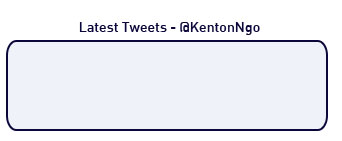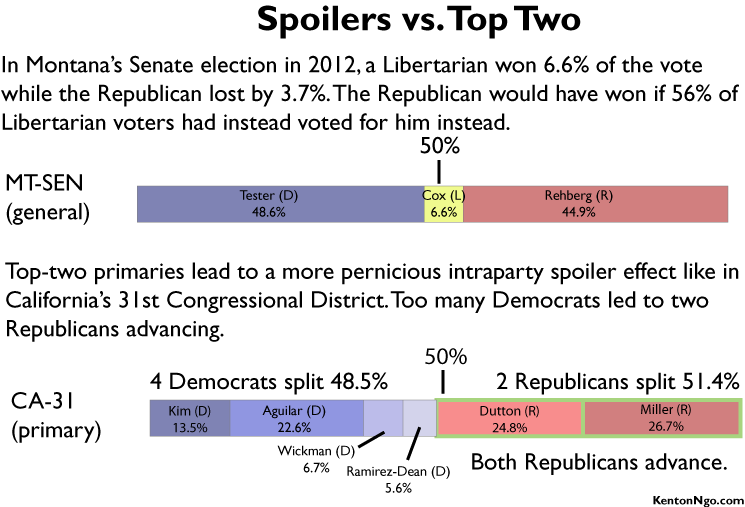Top-two primaries might seem to be more open on the surface, but they are a corruption of the primary process that gives party bosses more control, not less control over who runs for office. They strongly incentivize reducing the number of candidates, which violates the entire purpose of opening up the nomination process.
Chaos in normally staid legislative chambers can often be caused by abrupt bills on election reform, like the video at right of the Montana State Senate pushing through SB 408, a top-two primary referendum earlier this month (or like this Taiwanese Legislative Yuan fistfight). Montana Republicans have been annoyed since Libertarian candidates spoiled Republican candidates for Governor and Senator last year, handing the offices to Democrats. This spoiler effect is an artifact of our first-past-the-post electoral system, where voting for a third party helps the candidate farthest ideologically from you.
Democrats in that chamber have plenty to be angry about, but if I were a Republican activist I’d be cranky too. Rather than fix the spoiler effect of third-party candidates with Instant Runoff Voting (IRV), they’re trying to adopt a top-two primary that concentrates power in state parties and provides even more powerful incentives to quash grassroots primary challenges from both parties. It’s already happened in Washington State, will soon happen in California, and will happen in Montana if top-two passes. Let the charts below explain why.
A top-two primary combines candidates from all parties into a primary anyone can vote on and allows the top two (even if they’re of the same party) to proceed to the general election. Top two, in effect, solves the third party spoiler problem by introducing an intraparty spoiler problem. If too many candidates from one party run, they might split the vote so much that the other party wins the seats. A blanket primary which uses IRV would take the same candidate list and have voters rank them, eliminating the need for a second round, and crucially is unaffected by the number of candidates running on each side.
The partisan effect of the top-two system in Montana is caused entirely by the state’s unique political conditions: the Libertarians siphon off votes from the right without a corresponding effect on the left, and it is the partisan effect which receives the most attention. Since Libertarians are the most common spoilers in Montana, Republicans would benefit from a top-two primary, but there’s nothing inherent to the top-two primary that helps them, it’s an underlying condition.
The systemic effects, however, are neutral to the balance of power between the parties but have powerful impacts on the parties themselves. A top-two primary encourages both major parties to increase central control of candidate recruitment and stamp out intraparty challenges to avoid the clown car effect. Especially among the dominant party in a state (Democrats in Washington, Republicans in Montana) where more candidates might be inclined to run to begin with, this incredible incentive to centralize party control undermines the entire purpose of primaries, which was to take the candidate selection process out of the hands of party bosses and place it into the hands of voters.
It’s already been proven in Washington State, where Democratic Party chairman Dwight Pelz lamented that, “I, as party chairman, have to go and talk people into not participating, and I think that’s really unfortunate.” A 2012 paper by Gonzaga University’s John Beck and Kevin Henrickson uses a logit model of candidate counts in state legislative districts before and after the adoption of top-two and find that the number of Democratic candidates fell by 0.15 per seat, and that the probability that more than one Democrat would run fell by 8.6%. They did not find a similar result for Republican primaries, but speculate like I do that the dominant Democratic position in Washington State contributed to this. Fewer Republican incumbents can lead to fewer challengers.
California adopted top-two primaries in the same year they adopted radical non-partisan redistricting changes, scrambling the pro-incumbent impact of top-two. But as 2014 rolls around, you can bet that the state and national parties will be keen to quash as many primary challenges as they can to prevent the California 31st debacle from happening again. It’s cheaper to quash candidates from your ow party than to put up front candidates of the other party to try to achieve the same effect. Party activists at odds with their establishment have the most to lose. They already face the task of convincing a primary electorate that electability concerns don’t apply when nominating an activist, non-incumbent, or more ideological candidate, but with a top-two primary their very existence harms the electability of all candidates of their party.
What American voters need is a rational way to vote for a candidate that represents their interests, regardless of party or positioning within a party, without harming their own cause and handing offices to candidates they would’ve ranked last. Instant Runoff Voting, successfully used by Australia for years, does this and maximizes the voter’s choice. Top-two primaries, in contrast, are a half-assed solution that undermine the very purpose of primary elections with a deceptively open format on the surface that in reality grants even more power to state and national party insiders. Hopefully even the Republican grassroots will see what the problem is.


